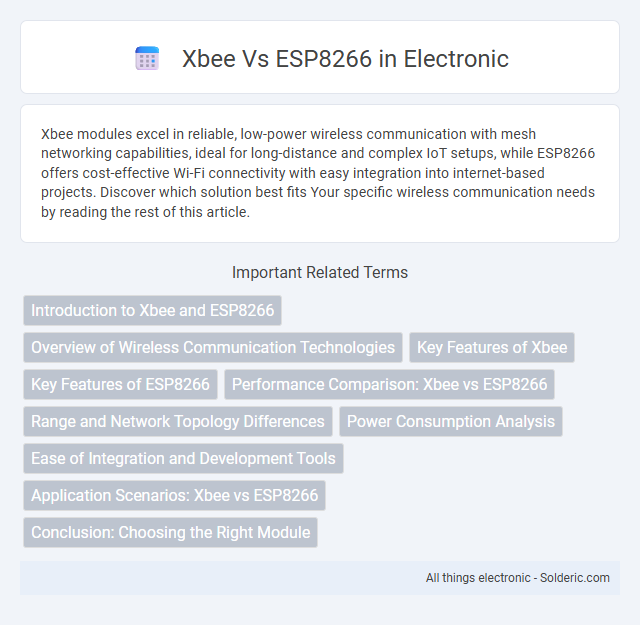Xbee modules excel in reliable, low-power wireless communication with mesh networking capabilities, ideal for long-distance and complex IoT setups, while ESP8266 offers cost-effective Wi-Fi connectivity with easy integration into internet-based projects. Discover which solution best fits Your specific wireless communication needs by reading the rest of this article.
Comparison Table
| Feature | Xbee | ESP8266 |
|---|---|---|
| Type | Wireless RF Module | Wi-Fi Module |
| Communication Protocol | Zigbee, 802.15.4 | IEEE 802.11 b/g/n (Wi-Fi) |
| Frequency | 2.4 GHz | 2.4 GHz |
| Range | Up to 1 mile (1.6 km) outdoor | Up to 300 meters (line of sight) |
| Data Rate | 250 kbps | Up to 72 Mbps |
| Power Consumption | Low power, suitable for battery-operated devices | Moderate power consumption |
| Security | AES 128-bit Encryption | WPA/WPA2 |
| Development Complexity | Moderate; requires configuration via XCTU software | Low; supports easy programming with Arduino and SDKs |
| Use Cases | IoT sensor networks, low power mesh networks | Wi-Fi based IoT projects, smart home devices, web servers |
| Cost | Higher price range | Low cost |
Introduction to Xbee and ESP8266
Xbee modules operate on Zigbee protocol, providing reliable, low-power wireless communication primarily used in mesh network configurations ideal for IoT and industrial applications. ESP8266 is a cost-effective Wi-Fi microchip with full TCP/IP stack, enabling standalone or microcontroller-based internet connectivity suitable for smart home projects and real-time data exchange. Both modules serve distinct wireless communication needs, with Xbee excelling in low-power, long-range mesh networks and ESP8266 dominating in affordable Wi-Fi connectivity.
Overview of Wireless Communication Technologies
XBee modules utilize Zigbee protocol, offering low-power, reliable mesh networking ideal for sensor networks and home automation, while ESP8266 supports Wi-Fi, providing high-speed internet connectivity for smart devices and IoT projects. XBee excels in long battery life and scalability in dense networks, whereas ESP8266 delivers broader internet access with easy integration into existing Wi-Fi networks. Your choice depends on whether you prioritize extensive range and network robustness with XBee or fast data throughput and simple internet connectivity with ESP8266.
Key Features of Xbee
Xbee modules offer robust wireless communication with Zigbee protocol support, enabling low-power, reliable, and secure mesh networking ideal for IoT applications. Their ease of integration with existing systems and compatibility with various microcontrollers make Xbee a versatile choice for complex sensor networks. Your projects benefit from Xbee's extended range and point-to-multipoint communication capabilities, which surpass those of ESP8266 for large-scale device networks.
Key Features of ESP8266
ESP8266 features a highly integrated Wi-Fi SoC with a full TCP/IP stack, enabling seamless wireless communication for IoT devices. It supports IEEE 802.11 b/g/n standards, operates in both station and access point modes, and offers low power consumption with deep sleep functionality. The module includes a 32-bit Tensilica processor, multiple GPIO pins, PWM, ADC, and SPI interfaces, making it versatile for various embedded applications.
Performance Comparison: Xbee vs ESP8266
Xbee modules offer reliable low-power, long-range communication suited for mesh networking, typically operating at 250 kbps with Zigbee protocol, making them ideal for industrial IoT applications requiring robust network topology. ESP8266 provides higher data throughput up to 72 Mbps over Wi-Fi, enabling faster internet connectivity and real-time data transmission in smart home projects, but with higher power consumption. Performance-wise, Xbee excels in stable, energy-efficient sensor networks, while ESP8266 outperforms in bandwidth-intensive, latency-sensitive wireless applications.
Range and Network Topology Differences
XBee modules typically offer a longer range of up to 1 mile in direct line-of-sight conditions, operating on the Zigbee protocol with support for mesh network topology that enhances network reliability by allowing devices to relay data through multiple nodes. ESP8266 has a shorter range, generally around 300 meters line-of-sight, and primarily uses Wi-Fi networks based on a star topology, where all devices connect directly to a central router or access point. The mesh capabilities of XBee make it suitable for extensive sensor networks, whereas ESP8266 is designed for internet connectivity with simpler network layouts.
Power Consumption Analysis
Xbee modules typically consume more power than ESP8266 due to their longer range and more robust communication protocols, often drawing around 40-50mA during transmission compared to the ESP8266's 70-80mA peak but better idle sleep modes. ESP8266 offers multiple sleep modes like deep sleep with consumption as low as 10uA, making it suitable for battery-operated IoT devices requiring energy efficiency. Xbee's higher power usage aligns with applications needing reliable mesh networking, while ESP8266 optimizes for Wi-Fi connectivity with minimal power footprint in intermittent data transmissions.
Ease of Integration and Development Tools
The ESP8266 boasts extensive development tools and libraries, including support for Arduino IDE, NodeMCU, and MicroPython, making it highly accessible for rapid prototyping and integration into IoT projects. XBee modules offer seamless integration with Digi's XCTU software for configuration and network management, simplifying setup for Zigbee mesh networking but requiring specialized hardware and protocols. ESP8266's open-source ecosystem enables flexible firmware development, whereas XBee excels in reliable, low-power wireless communication with less emphasis on software customization.
Application Scenarios: Xbee vs ESP8266
Xbee modules excel in industrial and remote sensor network applications due to their robust mesh networking capabilities and long-range communication up to several kilometers. ESP8266 is ideal for IoT projects requiring Wi-Fi connectivity, such as home automation, smart appliances, and real-time data transmission in urban environments. While Xbee supports low-power, low-data-rate use cases with secure, reliable connections, ESP8266 offers high data throughput and easy integration with internet protocols.
Conclusion: Choosing the Right Module
Xbee modules excel in robust, low-power, and reliable mesh networking ideal for industrial applications, while ESP8266 offers versatile Wi-Fi connectivity with cost-effective performance for IoT projects requiring internet access. Your choice depends on whether you prioritize long-range, stable device-to-device communication (Xbee) or seamless integration with Wi-Fi networks and cloud services (ESP8266). Evaluating project requirements like power consumption, network complexity, and data throughput ensures selecting the right wireless module.
Xbee vs ESP8266 Infographic

 solderic.com
solderic.com